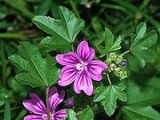
Malva sylvestris
Encyclopedia
Malva sylvestris is a species of the Mallow genus
Malva
in the family
of Malvaceae
and is considered to be the type species
for the genus. Known as common mallow to English speaking Europeans,
it acquired the common names of cheeses, high mallow and tall mallow (mauve des bois by the French)
as it migrated from its native home in Western Europe, North Africa and Asia through the English speaking world.
M. sylvestris is a vigorously healthy plant with showy flowers of bright mauve
-purple, with dark veins; a handsome plant, often standing 3 or 4 feet (1 m) high and growing freely in field
s, hedgerows and in fallow
fields.
Sources:
It is one of several species of different genera sometimes referred to as Creeping charlie, a term more commonly applied to Glechoma hederacea
(ground ivy).
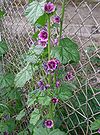
,
which is an annual
in North Africa,
biennial
in the Mediterranean
and a perennial
elsewhere
Three feet (one meter) tall,
(3 meters has been observed in a wild or escaped from cultivation setting, and several cultivated plants of 2 meter or more in height)
with a growth habit which can be straight
or decumbent,
branched and covered with fine soft hairs or none at all,
M. sylvestris is pleasing in appearance when it first starts to flower, but as the summer advances, "the leaves lose their deep green color and the stems assume a ragged appearance".
 Stem
Stem
s and leaves
: A thick, round and strong stem.
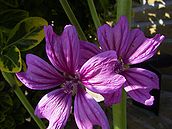 Flowers: Described as reddish-purple, bright pinkish-purple with dark stripes and bright mauve-purple, the flowers of Malva sylvestris appear in axillary
Flowers: Described as reddish-purple, bright pinkish-purple with dark stripes and bright mauve-purple, the flowers of Malva sylvestris appear in axillary
clusters of 2 to 4 and form irregularly and elongated along the main stem with the flowers at the base opening first.
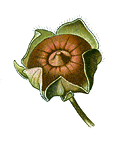 Fruits: Nutlet
Fruits: Nutlet
s strongly reticulate (10–12 mericarps, usually without hair, with sharp angle between dorsal and lateral surfaces, 5–6 millimters in diameter.
Chromosome number: 2n=42.
in eastern Australia, in the United States, Canada and Mexico probably escaped from cultivation.
Native
Source: USDA ARS GRIN
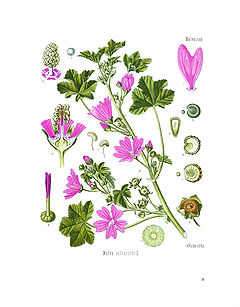 In 1931 Maud Grieve
In 1931 Maud Grieve
wrote that the "use of this species of Mallow has been much superseded by Marsh Mallow (Althaea officinalis
), which possesses its valuable properties in a superior degree, but it is still a favourite remedy with country people where Marsh Mallow is not obtainable," making this section more about history as it is about uses.
Decoration: In the past, the flowers were spread on doorways and woven into garland
s or chaplets
for celebrating May Day.
Food: The young leaves when boiled is a wholesome vegetable and was (1841) eaten in several parts of Europe; however, cattle do not seem to enjoy it and graze around them.
Medicinal:
Mucilage
is present in many of the Malvaceae
family, especially the fruit and were employed medicinally, as demulcent
s and emollients. The seeds were used internally in a decoction
as a demulcent
and diuretic
and the leaves made into poultice
s as an emollient for external applications.
The name comes from latin malva meaning soft ("molle", i.e. capable of softening).
It is used in phytotherapy: the active ingredients are found in the flowers and leaves, which are rich in mucillage, used for their emollinet and expectorant properties, in chatarrh forms of the upper airways.
The plant is largely used as emolliente and to sooth mucous membranes inflammations.
Mallow can be takes as a herbal tea to hydrate and soften the guts, and to regulate its functions due to its laxative action, due to the mucilage properties of swelling the guts, stimultaing their contractions and hence easing the emptying thereof.
Other: The species has long been used as a natural yellow dye, perhaps more recently, cream color, yellow and green dyes can be obtained from the plant and the seeds. A tincture of the flowers can make a very sensitive test for alkali
s.
Malva sylvestris Mauritiana Group.
 It is often grown as an ornamental plant
It is often grown as an ornamental plant
for its attractive flowers, produced for a long period through the summer. Numerous cultivar
s have been selected and named.
Cultivars of Malva sylvestris include: 'Alba', 'Annita', 'Aurora', 'Bardsey Blue', 'Blue Fountain', 'Brave Heart', 'Cottenham Blue', 'Gibbortello', 'Harry Hay', 'Highnam', 'Inky Stripe', 'Knockout', 'Magic Hollyhock', 'Mest', 'Mystic Merlin', 'Perry's Blue', 'Purple Satin', 'Richard Perry', 'Tournai', 'Windsor Castle', 'Zebrina' (soft lavender-purple striped with deep maroon veins)
and 'Zebrina Zebra Magis'.
Cultivar Groups:
Source: Stewart Robert Hinsley
Virus: Malva vein clearing potyvirus
which is transmitted by mechanical inoculation in a non-persistent manner via insects: Aphis umbrella (syn. Aphis malvae Koch) and Myzus persicae
(all are Aphididae
). The virus can be found in Tasmania
, Brazil, the former Czechoslovakia
, Germany, Israel, Italy, Portugal, California, Russia and the former Yugoslavia
.
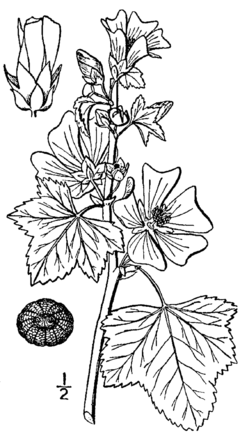 Africa:
Africa:
Australia:
Canada:
Europe:
Israel
New Zealand
Pakistan
United States
Genus
In biology, a genus is a low-level taxonomic rank used in the biological classification of living and fossil organisms, which is an example of definition by genus and differentia...
Malva
Malva
Malva is a genus of about 25–30 species of herbaceous annual, biennial, and perennial plants in the family Malvaceae , one of several closely related genera in the family to bear the common English name mallow. The genus is widespread throughout the temperate, subtropical and tropical regions of...
in the family
Family (biology)
In biological classification, family is* a taxonomic rank. Other well-known ranks are life, domain, kingdom, phylum, class, order, genus, and species, with family fitting between order and genus. As for the other well-known ranks, there is the option of an immediately lower rank, indicated by the...
of Malvaceae
Malvaceae
Malvaceae, or the mallow family, is a family of flowering plants containing over 200 genera with close to 2,300 species. Judd & al. Well known members of this family include okra, jute and cacao...
and is considered to be the type species
Type species
In biological nomenclature, a type species is both a concept and a practical system which is used in the classification and nomenclature of animals and plants. The value of a "type species" lies in the fact that it makes clear what is meant by a particular genus name. A type species is the species...
for the genus. Known as common mallow to English speaking Europeans,
it acquired the common names of cheeses, high mallow and tall mallow (mauve des bois by the French)
as it migrated from its native home in Western Europe, North Africa and Asia through the English speaking world.
M. sylvestris is a vigorously healthy plant with showy flowers of bright mauve
Mauve
Mauve is a pale lavender-lilac color, one of many in the range of purples. The color mauve is named after the mallow flower....
-purple, with dark veins; a handsome plant, often standing 3 or 4 feet (1 m) high and growing freely in field
Field (agriculture)
In agriculture, the word field refers generally to an area of land enclosed or otherwise and used for agricultural purposes such as:* Cultivating crops* Usage as a paddock or, generally, an enclosure of livestock...
s, hedgerows and in fallow
Crop rotation
Crop rotation is the practice of growing a series of dissimilar types of crops in the same area in sequential seasons.Crop rotation confers various benefits to the soil. A traditional element of crop rotation is the replenishment of nitrogen through the use of green manure in sequence with cereals...
fields.
Common names
Sources:
It is one of several species of different genera sometimes referred to as Creeping charlie, a term more commonly applied to Glechoma hederacea
Glechoma hederacea
Glechoma hederacea is an aromatic, perennial, evergreen creeper of the mint family Lamiaceae. It is commonly known as Ground-ivy, gill-over-the-ground or Creeping Charlie. It has numerous medicinal uses, and is commonly used as a tasty salad green in many countries...
(ground ivy).

Description
Malvus sylvestris is a spreading herbHerb
Except in botanical usage, an herb is "any plant with leaves, seeds, or flowers used for flavoring, food, medicine, or perfume" or "a part of such a plant as used in cooking"...
,
which is an annual
Annual plant
An annual plant is a plant that usually germinates, flowers, and dies in a year or season. True annuals will only live longer than a year if they are prevented from setting seed...
in North Africa,
biennial
Biennial plant
A biennial plant is a flowering plant that takes two years to complete its biological lifecycle. In the first year the plant grows leaves, stems, and roots , then it enters a period of dormancy over the colder months. Usually the stem remains very short and the leaves are low to the ground, forming...
in the Mediterranean
and a perennial
Perennial plant
A perennial plant or simply perennial is a plant that lives for more than two years. The term is often used to differentiate a plant from shorter lived annuals and biennials. The term is sometimes misused by commercial gardeners or horticulturalists to describe only herbaceous perennials...
elsewhere
Three feet (one meter) tall,
(3 meters has been observed in a wild or escaped from cultivation setting, and several cultivated plants of 2 meter or more in height)
with a growth habit which can be straight
or decumbent,
branched and covered with fine soft hairs or none at all,
M. sylvestris is pleasing in appearance when it first starts to flower, but as the summer advances, "the leaves lose their deep green color and the stems assume a ragged appearance".

Plant stem
A stem is one of two main structural axes of a vascular plant. The stem is normally divided into nodes and internodes, the nodes hold buds which grow into one or more leaves, inflorescence , conifer cones, roots, other stems etc. The internodes distance one node from another...
s and leaves
Leaf
A leaf is an organ of a vascular plant, as defined in botanical terms, and in particular in plant morphology. Foliage is a mass noun that refers to leaves as a feature of plants....
: A thick, round and strong stem.
- The leaves are borne upon the stem, are roundish, and have three or five to seven or five to nine shallow lobes, each 2 to 4 centimeters (1 to 2 inches) long, 2 to 5 centimeters wide (1 to 2 inches) and 5 to 10 centimeters (2 to 4 inches) in diameter. Downy, with hairs radiating from a common center and prominent veins on the underside.
- PetiolePetiole (botany)In botany, the petiole is the stalk attaching the leaf blade to the stem. The petiole usually has the same internal structure as the stem. Outgrowths appearing on each side of the petiole are called stipules. Leaves lacking a petiole are called sessile, or clasping when they partly surround the...
either 2 to 6 centimeters (1 to 3 inches) or 2 to 13 centimeters (1 to 5 or 6 inches) long.

Axillary
Axillary means "related to the axilla "."Axillary" may refer to:* Axillary artery* Axillary vein* Axillary nerve* Axillary bud...
clusters of 2 to 4 and form irregularly and elongated along the main stem with the flowers at the base opening first.
- M. sylvestris has an epicalyx (or false calyx) with oblong segments, two-thirds as long as calyx or 2–3 millimeters long and 1.5 millimeters wide. Its calyx is free to the middle, 3–6 millimeters long, with broadly triangular lobes or ovate mostly 5–7 millimeters long. The flowers are 2–4 times as long as the calyx;
- Petals are wrinkly to veined on the backs, more than 20 millimeters long or 15 to 25 millimeters long and 1 centimeter wide, eggshaped, margin notched with a fringe of hairlike projections.
- Slender flower stalks that are either 2 centimeters long or 1 to 3 centimeters long.
- Ten broad carpels in axillaryAxillaryAxillary means "related to the axilla "."Axillary" may refer to:* Axillary artery* Axillary vein* Axillary nerve* Axillary bud...
clusters; stamen about 3 millimters long, radiating from the center with short soft hairs.

Nutlet
Nutlet may refer to one of the following.*A small nut.*In botany, a nutlet is a pyrena or pyrene, which is a seed covered by a stony layer, such as the kernel of a drupe....
s strongly reticulate (10–12 mericarps, usually without hair, with sharp angle between dorsal and lateral surfaces, 5–6 millimters in diameter.
- Seeds or 'cheeses,' are brown to brownish green when ripe, about 2.5 millimeters long and wide 5 to 7 millimeters in diameter and are shaped like a cheese wheel which is where several of its common names came from.
Chromosome number: 2n=42.
Distribution
As a native Malva sylvestris spreads itself on waste and rough ground, by roads and railways throughout lowland England, Wales and Channel Islands, Siberia and scattered elsewhere. It has been introduced to and has become naturalisedNaturalisation (biology)
In biology, naturalisation is any process by which a non-native organism spreads into the wild and its reproduction is sufficient to maintain its population. Such populations are said to be naturalised....
in eastern Australia, in the United States, Canada and Mexico probably escaped from cultivation.
Native
- PalearcticPalearcticThe Palearctic or Palaearctic is one of the eight ecozones dividing the Earth's surface.Physically, the Palearctic is the largest ecozone...
:- Macaronesia: AzoresAzoresThe Archipelago of the Azores is composed of nine volcanic islands situated in the middle of the North Atlantic Ocean, and is located about west from Lisbon and about east from the east coast of North America. The islands, and their economic exclusion zone, form the Autonomous Region of the...
, Madeira Islands - Northern Africa: Algeria, Egypt, Libya, Morocco
- Arabian Peninsula: Saudi Arabia
- Western Asia: Afghanistan, Cyprus, Sinai, Iran, Israel, Jordan, Lebanon, Syria, Turkey
- Caucasus: Armenia, Azerbaijan, CiscaucasiaCiscaucasiaCiscaucasia , also Ciscaucasus or Fore-Caucasus, is a part of the Caucasus region, and of the North Caucasus in particular.The region is at the northern foothills of the Greater Caucasus range, from the Sea of Azov in the west to the Caspian Sea in the east, separated from the East European Plain...
, DagestanDagestanThe Republic of Dagestan is a federal subject of Russia, located in the North Caucasus region. Its capital and the largest city is Makhachkala, located at the center of Dagestan on the Caspian Sea...
, Georgia - Soviet Middle Asia: Kyrgyzstan, Tajikistan, Turkmenistan, Uzbekistan
- Mongolia: Mongolia
- China: XinjiangXinjiangXinjiang is an autonomous region of the People's Republic of China. It is the largest Chinese administrative division and spans over 1.6 million km2...
- Indian Subcontinent: Bhutan, India, Pakistan
- Northern Europe: Denmark, Finland, Ireland, Norway, Sweden, United Kingdom
- Middle Europe: Austria, Belgium, Czech Republic, Germany, Hungary, Netherlands, Poland, Slovakia, Switzerland
- East Europe: Belarus, Central RussiaCentral economic regionCentral economic region is one of twelve economic regions of Russia.Area: 484,000 km²; population: 30.5 million . Average population density—63/km². Over 80% of the population is urban....
, Central Black EarthCentral Black Earth economic regionCentral Black Earth economic region tr.: Tsentralno-Chernozyomny ekonomichesky rayon), sometimes called Central Chernozem or Central Chernozemic economic region, is one of twelve economic regions of Russia. See also Central Black Earth Region....
, Estonia, Latvia, Lithuania, Moldova, Northern RussiaNorthern economic regionNorthern economic region tr.: Severny ekonomichesky rayon) is one of twelve economic regions of Russia.-Composition:*Arkhangelsk Oblast*Republic of Karelia*Komi Republic*Murmansk Oblast*Nenets Autonomous Okrug*Vologda Oblast...
, North CaucasusNorth Caucasus economic regionNorth Caucasus economic region tr.: Severo-Kavkazsky ekonomichesky rayon) is one of twelve economic regions of Russia.In this area, descending northward from the principal chain of the Caucasus Mountains to a level plain, are found rich deposits of oil, natural gas, and coal. The major cities are...
, Northwestern RussiaNorthwestern economic regionNorthwestern economic region tr.: Severo-Zapadny ekonomichesky rayon) is one of twelve economic regions of Russia.-Composition:*Leningrad Oblast*Novgorod Oblast*Pskov Oblast*federal city of St. Petersburg-Socio-economic indicators:...
, VolgaVolga economic regionVolga economic region tr.: Povolzhsky ekonomichesky rayon) is one of twelve economic regions of Russia.-Composition:*Astrakhan Oblast*Republic of Kalmykia*Penza Oblast*Samara Oblast*Saratov Oblast*Republic of Tatarstan*Ulyanovsk Oblast...
, UralsUrals economic regionUral economic region tr.: Uralsky ekonomichesky rayon) is one of twelve economic regions of Russia. This prominent industrial region consists of the following subdivisions : Bashkortostan , Chelyabinsk Oblast , Kurgan Oblast , Orenburg Oblast , Perm Krai , Sverdlovsk Oblast and Udmurt...
, Volga-VyatkaVolga-Vyatka economic regionVolga-Vyatka economic region tr.: Volgo-Vyatsky ekonomichesky rayon) is one of twelve economic regions of Russia.-Composition:*Chuvash Republic*Kirov Oblast*Mari El Republic*Republic of Mordovia*Nizhny Novgorod Oblast...
, Ukraine - Southeastern Europe: Albania, Bosnia and Herzegovina, Bulgaria, Croatia, Greece, Italy, Macedonia, Montenegro, SardiniaSardiniaSardinia is the second-largest island in the Mediterranean Sea . It is an autonomous region of Italy, and the nearest land masses are the French island of Corsica, the Italian Peninsula, Sicily, Tunisia and the Spanish Balearic Islands.The name Sardinia is from the pre-Roman noun *sard[],...
, Serbia, SicilySicilySicily is a region of Italy, and is the largest island in the Mediterranean Sea. Along with the surrounding minor islands, it constitutes an autonomous region of Italy, the Regione Autonoma Siciliana Sicily has a rich and unique culture, especially with regard to the arts, music, literature,...
, Slovenia, Romania - Southwestern Europe: Balearic IslandsBalearic IslandsThe Balearic Islands are an archipelago of Spain in the western Mediterranean Sea, near the eastern coast of the Iberian Peninsula.The four largest islands are: Majorca, Minorca, Ibiza and Formentera. The archipelago forms an autonomous community and a province of Spain with Palma as the capital...
, CorsicaCorsicaCorsica is an island in the Mediterranean Sea. It is located west of Italy, southeast of the French mainland, and north of the island of Sardinia....
, France, Portugal, Spain
- Macaronesia: Azores
Source: USDA ARS GRIN
Uses

Maud Grieve
Sophia Emma Magdalene Grieve was the Principal and Founder of The Whins Medicinal and Commercial Herb School and Farm at Chalfont St. Peter in Buckinghamshire, England. Maud Grieve was a Fellow of the Royal Horticultural Society with an encyclopedic knowledge of medicinal plants...
wrote that the "use of this species of Mallow has been much superseded by Marsh Mallow (Althaea officinalis
Althaea officinalis
Althaea officinalis is a species indigenous to Africa, which is used as a medicinal plant and ornamental plant...
), which possesses its valuable properties in a superior degree, but it is still a favourite remedy with country people where Marsh Mallow is not obtainable," making this section more about history as it is about uses.
Decoration: In the past, the flowers were spread on doorways and woven into garland
Garland
A garland is a class of decoration, of which there are many types.Garland may also refer to:-Places:*Garland, Arkansas, a town in Miller County*Garland County, Arkansas*Garland, Maine, a town in Penobscot County...
s or chaplets
Corolla (chaplet)
The term corolla or corollæ appears in a chapter title in Pliny the Elder's Naturalis Historia: "Who invented the art of making garlands: When they first received the name of 'corollæ,' and for what reason."...
for celebrating May Day.
Food: The young leaves when boiled is a wholesome vegetable and was (1841) eaten in several parts of Europe; however, cattle do not seem to enjoy it and graze around them.
Medicinal:
Mucilage
Mucilage
Mucilage is a thick, gluey substance produced by most plants and some microorganisms. It is a polar glycoprotein and an exopolysaccharide.It occurs in various parts of nearly all classes of plant, usually in relatively small percentages, and is frequently associated with other substances, such as...
is present in many of the Malvaceae
Malvaceae
Malvaceae, or the mallow family, is a family of flowering plants containing over 200 genera with close to 2,300 species. Judd & al. Well known members of this family include okra, jute and cacao...
family, especially the fruit and were employed medicinally, as demulcent
Demulcent
A demulcent is an agent that forms a soothing film over a mucous membrane, relieving minor pain and inflammation of the membrane. Demulcents are sometimes referred to as mucoprotective agents. Demulcents such as pectin, glycerin, honey, and syrup are common ingredients in cough mixtures...
s and emollients. The seeds were used internally in a decoction
Decoction
Decoction is a method of extraction, by boiling, of dissolved chemicals, or herbal or plant material, which may include stems, roots, bark and rhizomes. Decoction involves first mashing, and then boiling in water to extract oils, volatile organic compounds, and other chemical substances...
as a demulcent
Demulcent
A demulcent is an agent that forms a soothing film over a mucous membrane, relieving minor pain and inflammation of the membrane. Demulcents are sometimes referred to as mucoprotective agents. Demulcents such as pectin, glycerin, honey, and syrup are common ingredients in cough mixtures...
and diuretic
Diuretic
A diuretic provides a means of forced diuresis which elevates the rate of urination. There are several categories of diuretics. All diuretics increase the excretion of water from bodies, although each class does so in a distinct way.- Medical uses :...
and the leaves made into poultice
Poultice
A poultice, also called cataplasm, is a soft moist mass, often heated and medicated, that is spread on cloth over the skin to treat an aching, inflamed, or painful part of the body. It can be used on wounds such as cuts...
s as an emollient for external applications.
The name comes from latin malva meaning soft ("molle", i.e. capable of softening).
It is used in phytotherapy: the active ingredients are found in the flowers and leaves, which are rich in mucillage, used for their emollinet and expectorant properties, in chatarrh forms of the upper airways.
The plant is largely used as emolliente and to sooth mucous membranes inflammations.
Mallow can be takes as a herbal tea to hydrate and soften the guts, and to regulate its functions due to its laxative action, due to the mucilage properties of swelling the guts, stimultaing their contractions and hence easing the emptying thereof.
Other: The species has long been used as a natural yellow dye, perhaps more recently, cream color, yellow and green dyes can be obtained from the plant and the seeds. A tincture of the flowers can make a very sensitive test for alkali
Alkali
In chemistry, an alkali is a basic, ionic salt of an alkali metal or alkaline earth metal element. Some authors also define an alkali as a base that dissolves in water. A solution of a soluble base has a pH greater than 7. The adjective alkaline is commonly used in English as a synonym for base,...
s.
Subspecies
Plants previously often described as Malva sylvestris var. malaca are now considered a Cultivar GroupCultivar group
In naming cultivated plants, a Group is a formal classification category, under the International Code of Nomenclature for Cultivated Plants :The term "Group" was introduced in the 2004 ICNCP, replacing the "Cultivar-group" of the 1995 ICNCP.A Group is united by some common trait; for example...
Malva sylvestris Mauritiana Group.
Cultivation

Ornamental plant
Ornamental plants are plants that are grown for decorative purposes in gardens and landscape design projects, as house plants, for cut flowers and specimen display...
for its attractive flowers, produced for a long period through the summer. Numerous cultivar
Cultivar
A cultivar'Cultivar has two meanings as explained under Formal definition. When used in reference to a taxon, the word does not apply to an individual plant but to all those plants sharing the unique characteristics that define the cultivar. is a plant or group of plants selected for desirable...
s have been selected and named.
Cultivars of Malva sylvestris include: 'Alba', 'Annita', 'Aurora', 'Bardsey Blue', 'Blue Fountain', 'Brave Heart', 'Cottenham Blue', 'Gibbortello', 'Harry Hay', 'Highnam', 'Inky Stripe', 'Knockout', 'Magic Hollyhock', 'Mest', 'Mystic Merlin', 'Perry's Blue', 'Purple Satin', 'Richard Perry', 'Tournai', 'Windsor Castle', 'Zebrina' (soft lavender-purple striped with deep maroon veins)
and 'Zebrina Zebra Magis'.
Cultivar Groups:
-
- Malva sylvestris L. Mauritiana group: , , , Malva mauritiana used to be recognized as a species whose range is IberiaIberian PeninsulaThe Iberian Peninsula , sometimes called Iberia, is located in the extreme southwest of Europe and includes the modern-day sovereign states of Spain, Portugal and Andorra, as well as the British Overseas Territory of Gibraltar...
, Italy and Algeria. Garden plants are often called Malva sylvestris var. mauritiana and they make a cultivar group that includes:
-
- 'Bibor Felho'
- 'Moravia'
- Malva sylvestris L. Mauritiana group: , , , Malva mauritiana used to be recognized as a species whose range is Iberia
-
- Malva sylvestris L. Eriocarpa group: Hairy seeds and hairy stems found between Italy and the HimalayasHimalayasThe Himalaya Range or Himalaya Mountains Sanskrit: Devanagari: हिमालय, literally "abode of snow"), usually called the Himalayas or Himalaya for short, is a mountain range in Asia, separating the Indian subcontinent from the Tibetan Plateau...
, Central Asia and China.
- Malva sylvestris L. Eriocarpa group: Hairy seeds and hairy stems found between Italy and the Himalayas
-
- Malva sylvestris L. Canescens group: Every part except for the flower is covered with dense white woolly hair, growing in the MontpellierMontpellier-Neighbourhoods:Since 2001, Montpellier has been divided into seven official neighbourhoods, themselves divided into sub-neighbourhoods. Each of them possesses a neighbourhood council....
region of France, and on the BalearicBalearic IslandsThe Balearic Islands are an archipelago of Spain in the western Mediterranean Sea, near the eastern coast of the Iberian Peninsula.The four largest islands are: Majorca, Minorca, Ibiza and Formentera. The archipelago forms an autonomous community and a province of Spain with Palma as the capital...
Isles. Some 19th century botanical works called this group Malva sylvestris L. var. canescens.
- Malva sylvestris L. Canescens group: Every part except for the flower is covered with dense white woolly hair, growing in the Montpellier
-
- Malva sylvestris L. Sterile Blue group: Vegetatively propagated pale violet-blue flowered cultivars:
-
- MARINA 'Dema'
- 'Primley Blue'
Source: Stewart Robert Hinsley
Virus: Malva vein clearing potyvirus
Potyvirus
Potyviruses infect plants and belong to the family Potyviridae. The genus is named after the type virus - Potato Virus Y.The Potyvirus, like the Begomoviruses, have ~30% of the currently known plant viruses and have at least 180 definitive and possible members...
which is transmitted by mechanical inoculation in a non-persistent manner via insects: Aphis umbrella (syn. Aphis malvae Koch) and Myzus persicae
Myzus persicae
Myzus persicae, known as the green peach aphid, is a small green aphid. It is the most significant aphid pest of peach trees, causing decreased growth, shriveling of the leaves and the death of various tissues...
(all are Aphididae
Aphididae
Aphididae is a very large insect family in the aphid superfamily , of the order Hemiptera. There are several thousand species in this family, many of which are well known for being serious plant pests...
). The virus can be found in Tasmania
Tasmania
Tasmania is an Australian island and state. It is south of the continent, separated by Bass Strait. The state includes the island of Tasmania—the 26th largest island in the world—and the surrounding islands. The state has a population of 507,626 , of whom almost half reside in the greater Hobart...
, Brazil, the former Czechoslovakia
Czechoslovakia
Czechoslovakia or Czecho-Slovakia was a sovereign state in Central Europe which existed from October 1918, when it declared its independence from the Austro-Hungarian Empire, until 1992...
, Germany, Israel, Italy, Portugal, California, Russia and the former Yugoslavia
Yugoslavia
Yugoslavia refers to three political entities that existed successively on the western part of the Balkans during most of the 20th century....
.
External links

Australia:
Canada:
Europe:
Israel
New Zealand
Pakistan
United States

